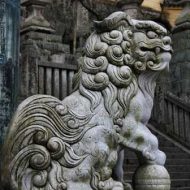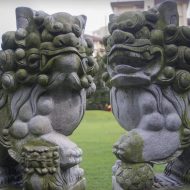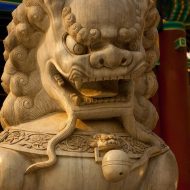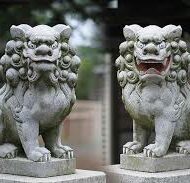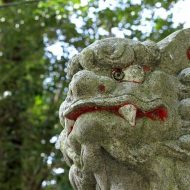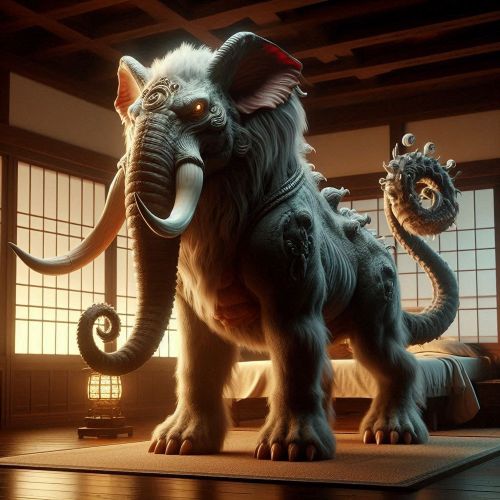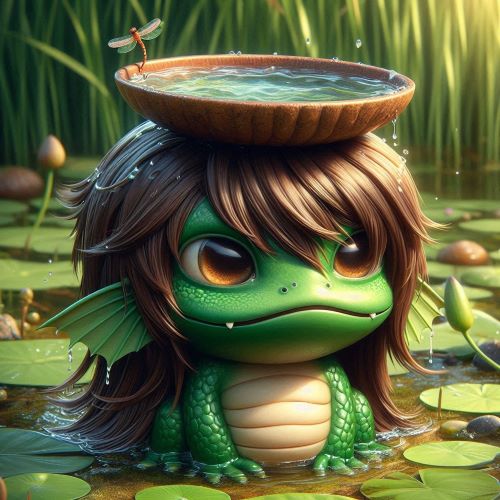Komainu : The Guardian Lion Dogs of Japan
Listen
At a glance
| Description | |
|---|---|
| Origin | Japanese Mythology |
| Classification | Hybrids |
| Family Members | N/A |
| Region | Japan |
| Associated With | Protection, Temples |
Komainu
Introduction
Standing silently at the entrances of Japanese shrines and temples, the Komainu, or “Lion Dogs,” are among Japan’s most recognizable and enduring mythological symbols. Carved from stone or cast in bronze, these twin guardians protect sacred spaces from evil spirits, their vigilant expressions embodying both ferocity and serenity.
Though rooted in ancient spiritual symbolism, Komainu are more than decorative sculptures — they represent a living tradition of divine guardianship, blending influences from India, China, and Korea into a distinctly Japanese spiritual icon. Their watchful presence at the thresholds of Shinto shrines and Buddhist temples reminds all who pass that purification, respect, and mindfulness are essential before entering sacred ground.
The Komainu stand as keepers of balance, blending the strength of a lion and the loyalty of a dog, serving as both protectors of the divine and reflections of human faith.
Physical Traits
Komainu always appear in pairs, representing complementary cosmic forces. One usually has its mouth open, forming the sound “A,” while the other keeps its mouth closed, forming “Un” — together symbolizing the alpha and omega of existence, the beginning and the end. This sacred pairing, known as A-un, reflects the concept of duality and balance found throughout Japanese philosophy and Buddhism.
Physically, Komainu resemble muscular lions with canine features. Their powerful bodies are adorned with curling manes, fierce eyes, and sharp fangs. Often, one paw rests upon a symbolic object — a sphere, cub, or lotus — signifying guardianship or continuity. Traditional sculptures capture motion and grace simultaneously, suggesting readiness to act yet deep tranquility within.
Over centuries, artists have evolved Komainu’s appearance: early examples were more lion-like, inspired by Chinese guardian lions (shishi), while later ones developed softer, dog-like features reflecting local Shinto influence and the Japanese love of faithful dogs.
Family
While Komainu are not biological beings with genealogical families, they belong to a vast lineage of guardian spirits shared across Asia. Their origin can be traced back to Indian lions that flanked Buddhist thrones, later adopted into Chinese culture as Shishi or “Foo Dogs,” and eventually introduced to Japan through Korea during the Nara period (8th century).
In the Japanese context, the pair evolved into Kara-shishi (lion from China) and Koma-inu (dog from Korea), reflecting the nation’s historical cultural synthesis. Over time, the two merged into one hybrid figure: the Komainu we recognize today.
In Shinto cosmology, they are considered messengers and guardians of kami (spirits) — especially protective deities such as Hachiman, Inari, and Amaterasu. In Buddhist temples, they are sometimes seen as protectors of the Dharma, standing alongside Niō guardians or within temple gates (Sanmon).
Other Names
Komainu are known by several names that reflect their form and function. They are sometimes called Shishi (獅子) in Japan, particularly when their features are more lion-like. In Okinawa, a closely related guardian called the Shisa serves a similar purpose, guarding homes and temples with the same “A-un” symbolism.
Other regional terms include Goryō-inu (“spirit dogs”) or Shishigashira (“lion heads”), depending on their depiction. In English, they are often referred to as Lion Dogs, Temple Guardians, or Japanese Foo Dogs, though these names only partially capture their religious and cultural depth.
Powers and Abilities
Komainu’s powers derive from their role as guardians of sacred thresholds. They are believed to ward off evil spirits, disease, and misfortune, maintaining purity within the spiritual space they guard. The one with the open mouth expels evil, while the one with the closed mouth keeps in blessings — a perfect balance of protection and preservation.
Spiritually, Komainu symbolize alert consciousness and courage. Their vigilant stance teaches mindfulness — to be aware of one’s surroundings and inner world before stepping into divine space. Some traditions believe Komainu can animate at night or during times of great danger to defend the shrine or its devotees.
Their protective energy extends beyond physical temples. Small Komainu statues are often placed at home entrances, representing domestic guardianship. In folklore, they’re sometimes credited with averting calamities, dispelling curses, and granting courage to the righteous.
Beyond protection, they embody the discipline of spiritual readiness — always watchful, never idle, poised between calmness and power.
Modern Day Influences
Today, Komainu remain a living presence in Japanese life, culture, and art. Every Shinto shrine, from grand sanctuaries like Ise and Meiji to local community shrines, features these guardian pairs. While their ancient function endures, modern interpretations of Komainu have expanded beyond religion into architecture, design, and popular culture.
Artists reinterpret them in ceramics, digital art, and even anime as symbols of loyalty and bravery. In Okinawa, Shisa guardians (Komainu’s cultural cousins) are seen on rooftops and gates, continuing the practice of spiritual protection in modern homes.
In the 21st century, Komainu also serve as icons of Japanese cultural identity — representing harmony between imported spiritual traditions and native Shinto beliefs. Globally, their image has been adopted in art, tattoos, and design as an emblem of protection and strength blended with serenity.
Within contemporary spirituality, the Komainu’s symbolism resonates with mindfulness and boundary setting — guarding one’s inner sanctum, just as they guard the shrines of the gods. Thus, from ancient temple steps to modern cityscapes, Komainu continue their eternal watch, bridging centuries of faith and artistry.
Related Images
Source
Addiss, S. (1992). Japanese Ghosts and Demons: Art of the Supernatural. George Braziller.
Reader, I. (1991). Religion in Contemporary Japan. University of Hawaii Press.
Ponsonby-Fane, R. A. B. (1962). Studies in Shinto and Shrines. Kyoto University Press.
Wikipedia contributors. (n.d.). Komainu. In Wikipedia, The Free Encyclopedia. https://en.wikipedia.org/wiki/Komainu
JapanObjects. (2023). Komainu: The Sacred Guardians of Japan’s Shrines. https://japanobjects.com/features/komainu
Nippon.com. (2022). Japan’s Shrine Guardians: The Story of Komainu. https://www.nippon.com/en/japan-topics/g01098/
AncientOrigins. (2021). The Komainu: Lion Dogs Protecting Japan’s Sacred Spaces. https://www.ancient-origins.net/artifacts-other-artifacts/komainu-lion-dogs-0014997
JapanTalk. (2020). Komainu: Shrine Guardian Statues of Japan. https://www.japan-talk.com/jt/new/komainu
Frequently Asked Questions
What does komainu symbolize?
The Komainu, mythical lion-dogs found in Japan, are potent symbols of protection, duality, strength, and wisdom. Standing guard at the entrances of shrines and temples, they ward off evil spirits with their fierce stare and symbolize both the beginning (aum) and the end (um) through their open and closed mouths. Their lion features represent royalty, power, and courage, while their watchful eyes convey wisdom and knowledge. Ultimately, the Komainu represent the powerful guardians of sacred spaces, reminding us of the importance of balance and the constant presence of divine protection.
What are the powers of a komainu?
Though their exact powers are subject to interpretation, Komainu are generally believed to possess incredible strength, longevity, and senses that allow them to detect and combat evil. Some stories even grant them the ability to speak, come alive at night, or act as intermediaries between humans and the divine. Ultimately, these mythical lion-dogs symbolize potent protection, warding off evil and safeguarding sacred spaces with their unwavering vigilance and spiritual might.
Is the komainu male or female?
There are different interpretations regarding the gender of Komainu. According to one tradition, the Komainu with the open mouth is considered male, while the one with the closed mouth is considered female. Another tradition suggests that the Komainu on the left is male, while the one on the right is female. Therefore, depending on the tradition followed, a Komainu could be either male or female.
Which komainu is male?
Although visible genitals are rare, the left one is believed to be male, the right one female. It’s also sometimes said that the open-mouthed animal is male, while the other is female. So, the male Komainu could either be the one on the left or the one with its mouth open, depending on the tradition followed.
Is komainu a dog?
Komainu, commonly known as lion-dogs in English, are mythical beings that traditionally stand guard at the entrances of Shinto shrines in Japan. Usually appearing in pairs, these creatures exhibit a distinctive blend of dog and lion characteristics.


